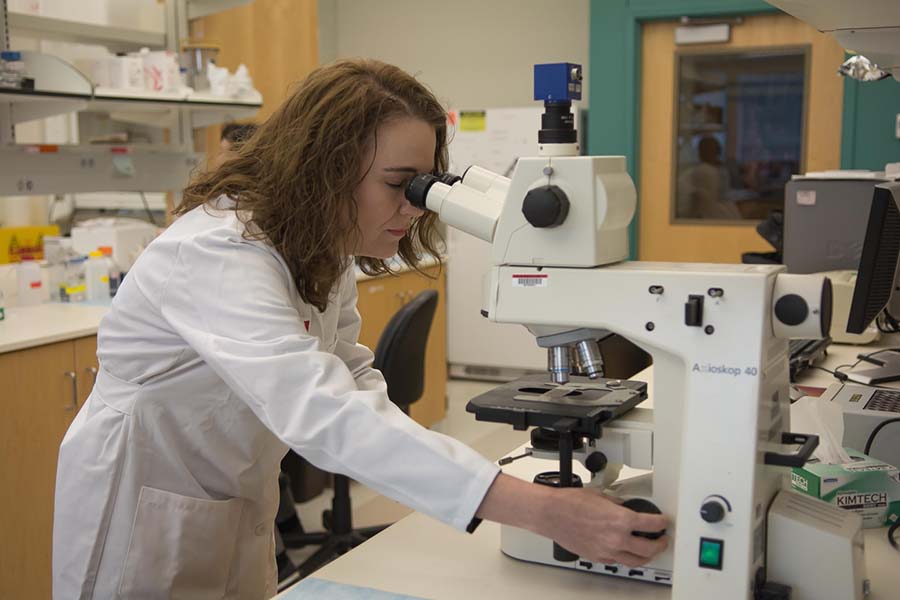Research

Our investigators are actively conducting individual and collaborative projects on Staphylococcus and related diseases, including basic science and clinical research.
The center fosters the interactions of basic science researchers with clinicians to develop new therapies and treatments for staph.
Basic Science Research
Our investigators are working toward a better understanding of staph diseases, which will provide the knowledge that eventually will lead to better diagnoses, preventions, and new treatments.
Our interdisciplinary group illustrates the need to have a multifaceted, multidirectional approach to researching staph, whether through the study of molecular or cellular biology, proteomics, immunology or pharmaceutical sciences.
Current Projects
A summary of current basic science research projects.
Naturally occurring antimicrobial peptides (AMPs) are universal effector molecules that directly eliminate invading pathogenic bacteria, fungi, viruses, and parasites. In mammals, including humans, such peptides may also modulate the adaptive immune systems. To date, more than 1,600 AMPs have been identified in bacteria, fungi, plants, and animals. To better manage this information, Dr. Wang's laboratory has established the Antimicrobial Peptide database (APD) as a tool for AMP naming, classification, search, statistical analysis, prediction, and design. Their database is also a useful resource for developing novel antimicrobial agents. These miniature proteins are capable of adopting a variety of three-dimensional structures, inspiring the design of natural mimics that benefit mankind. The objective of one of their NIH-funded projects is to develop AMPs into novel anti-HIV microbicides in collaboration with ImQuest BioSciences.
His lab is particularly interested in an in-depth understanding of the functional roles of human AMPs and their relationships with human diseases, including cancer. Recently, they have solved high-quality structures of human cathelicidin LL-37 and its important fragments by multidimensional nuclear magnetic resonance (NMR) spectroscopy. Dioctanoyl phosphatidylglycerol (D8PG) has been established as a new and unique membrane-mimetic model, which enables the detection of Phe-PG and Arg-PG interactions. Based on three-dimensional structures, they have identified the most potent region within LL-37 against MRSA, thereby identifying a useful template for designing novel therapeutic compounds against this superbug (US Patent 7,465,784). To elucidate the mechanism of action, they are utilizing a variety of biophysical and biochemical techniques. Their studies will lay the foundation for peptide engineering with a goal to overcome the hurdles (stability, toxicity, and production) on the way to the development of natural AMPs into novel therapeutics.
Another research direction of high interest to Dr. Wang is to engineer molecules that control protein-mediated signal transduction pathways essential for bacterial survival or infection in collaboration with colleagues in the Center for Staphylococcal Research (CSR). The lead compound will be optimized by combining NMR-based library screening with rational design based on three-dimensional structures of protein-protein complexes.
Clinical Research
Our center foster's the interactions of basic science researchers with clinicians, such as Mark Rupp, MD, infectious diseases specialist, and Kevin Garvin, MD, chairman of the department of orthopedic surgery, to develop new therapies and treatments for staph.
Current Projects
A summary of current clinical research projects.
Dr. Kevin Garvin is an orthopedic surgeon specializing in hip and knee reconstruction. His research interest focuses on the pathogenesis, prevention, and treatment of musculoskeletal infections caused by emerging multi-resistant strains of bacteria in the surgical setting. As chair of the Department of Orthopedic Surgery and Rehabilitation at UNMC, Dr. Garvin leads a dynamic team of clinicians and researchers who have earned a strong regional, national, and international reputation for excellence in patient care, orthopedic education, and expanding cutting-edge research. He is committed to collaborative research and through the CSR several projects are underway.
Nebraska Transposon Mutant Library
To enhance the research capabilities of the Staphylococcal research community, our center generated a collection of sequence-defined transposon (Tn) insertion mutants of Staphylococcus aureus (S. aureus) termed the Nebraska Transposon Mutant Library.
This collection of strains contains mutant derivatives of USA300 LAC in which individual genes have been disrupted by the insertion of the mariner Tn bursa aurealis. By determining the nucleotide sequences of the junction fragments containing the end of the Tn and the flanking DNA, the insertion sites have been identified for each mutant in the collection.
In collaboration with Network on Antimicrobial Resistance in Staphylococcus aureus, these mutants have been made available to the staphylococcal research community. The ultimate goal is to generate mutations in each of the approximately 2,000 non-essential genes in the genome and make these mutants available for experimental analysis.
Parental Strain
The strain used to generate the Nebraska Library was derived from S. aureus USA300 LAC, a highly characterized community-associated methicillin-resistant S. aureus strain isolated from the Los Angeles County jail. This strain contains three small plasmids, one encoding resistance to tetracycline and another encoding erythromycin resistance. The third plasmid is cryptic. For ease of genetic manipulation and to avoid interference with subsequent transposition events involving bursa aurealis, all three plasmids were cured, yielding strain USA300 JE2 that was used for all subsequent Tn mutagenesis experiments.
Funding Sources
The construction of the Nebraska Library was made possible by funding from the Department of Defense. Storage and subsequent dissemination of the library, as with all isolates in the NARSA collection is funded by the National Institutes of Health.